|
Wing Keel Travails
by Gary
Blankenship
It’s surprising, at least to me, how many people become
infatuated with sailing and boatbuilding, procure a design, and
then with little to guide them but impetuosity proceed to make
changes, including to hull and rig.
Then again experimentation is the necessary ingredient for advancing
any art or science, but even when you supposedly know what you’re
doing, it’s easy to get carried away. I’ve had lots
of time recently to contemplate on whether I’ve crossed
the boundary from careful innovation to reckless tinkering.
The experimental platform is a 30-foot custom Phil Bolger design
(#457), Le Dulci-Mer, built and launched 17 years ago. The original
goal was to develop a single-handed ocean racer suitable for the
OSTAR, Because of family considerations, the race was impossible
to do, but the boat was a joy to sail. It was refined over the
years; the original 7-foot draft was shortened to 5.5 feet in
deference to Florida Gulf Coast realities and the original dipping
lug rig (which took three to five minutes to tack) was altered
to a balanced lug, which is handy and can be raised, reefed and
lowered from the cockpit. It costs some windward performance but
gains on downwind runs.
|
Here's my boat as it was originally
built, with the lower, shorter cabin, non-lowering mast, flush
cockpit and the motor hung off a bracket in back. It's being
sailed off Carrabelle in the St. George Sound. This picture
is about 10 years old. (click to enlarge) |
But after several years, I began to question the practicality
of the boat. The still relatively deep draft meant the boat had
to be kept an hour and a half away from home, and the ocean-going,
low cabin meant less than five-feet of headroom. (Accommodations
are spartan by anyone’s standards, only two berths and barely
room for a porta potty, but I’ve always liked the simplicity,
if not the necessary stooping.) The cabin, with large Lexan windows
for inside visibility, also was uncomfortably hot in the Florida
summer. Essentially I was using the boat for day sailing and overnighting,
which didn’t seem a smart use of its capabilities.
I got to have lunch about five years ago with Bolger and his
wife, Susanne, during a trip to the Boston area and in passing
mentioned my reservations. In about 10 minutes, they had barnstormed
a number of changes to address my concerns. I was hooked. A few
months later, they sent the revised plans.
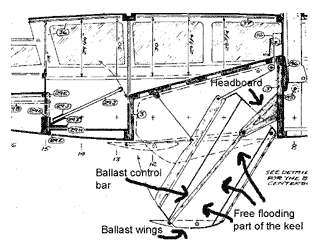
Detail of Wingkeel. (click to enlarge)
Basically, there were four major changes to Le Dulci-Mer:
• The cabin was lengthened and made higher. Also, there
are hatches the entire length for ventilation. There are a couple
cross beams, so it’s not quite a Birdwatcher cabin top,
but it’s close. The cabin is a great success, improving
the livability of the interior, although, alas, while it has character
I don’t think it’s as attractive as the original.
• The mast was mounted in a tabernacle and made to pivot,
eliminating the need for a crane to lower the mast. Except for
one slight problem with the original design for the hoisting/lowering
line, this has worked.
• The flush decked cockpit was overhauled. The outboard
motor had been mounted on a bracket off the stern. That made it
hard to get at, plus vulnerable to cavitation in the short chop
of the Gulf. Bolger designed in a footwell, with a motor mount
board at the back in an uncovered well. This moved the motor about
two feet forward of the transom, requiring that the transom be
cut in two. Bolger called for two shallow rudders on either side
of the motor cutout; I’ve gone with one deeper rudder offset
to starboard to save weight and also reuse the modified existing
rudder.
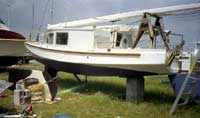 This
photo shows the modified boat, with the higher cabin and the
fold down mast. The transom, at the far right remains unmodified,
except for a shallower, wider rudder with an end plate. On
the far left is a parital view of the old fin keel, on the
ground to the right are the molded wings for the new keel,
and the black and white thing above them is the new keel.
The white is the epoxy undercoating and the black is bottom
paint. The bar under the middle of the boat is the ballast
control bar, the headboard and bar have already been installed
here. (click to enlarge) This
photo shows the modified boat, with the higher cabin and the
fold down mast. The transom, at the far right remains unmodified,
except for a shallower, wider rudder with an end plate. On
the far left is a parital view of the old fin keel, on the
ground to the right are the molded wings for the new keel,
and the black and white thing above them is the new keel.
The white is the epoxy undercoating and the black is bottom
paint. The bar under the middle of the boat is the ballast
control bar, the headboard and bar have already been installed
here. (click to enlarge) |
• The biggest change was to replace the keel. Rather than
the former fixed fin, the keel would be shallower, would pivot
like a centerboard, and the wings would cantilever, remaining
parallel to the bottom as the keel retracts. It should be explained
that the original keel, for construction simplicity, was mounted
in a keel case that was similar to a centerboard case. The case,
about 18 inches high, ran down the middle of the main cabin, and
the keel was bolted in place to the case. The new plan call for
raising the case, about two inches at the aft end and almost 30
at the forward end, to make room for the lifting keel. (Okay,
so it’s like a centerboard. But when it gets this heavy,
1,400 to 1,500 pounds total, I think of it as a moveable keel.)
The cantilever mechanism was brilliant simplicity. The steel,
air-foiled keel is hollow and free flooding, with openings on
top and bottom. The foil-shaped wings — cast of lead —
mount on a pivot about a third of the way back. An I-beam runs
through the keel to a second pivot about two-thirds of the way
back on the wings. The geometry is such that the I-beam cannot
simply be attached to the headblock of the keel case; the wings
would not maintain their proper orientation (parallel to the bottom)
as the keel rotates up and down. To get the proper pivot, a triangular
headboard was bolted perpendicular to the keel headblock and which
actually extended through the hollow top of the keel. The I-beam,
or ballast control bar, was fastened to this with a 3/4-inch pin,
to allow free rotation. Draft was now about 4 feet 9 inches with
the keel fully down and about 2 feet with it fully raised.
 |
side view of the boat, giving a better idea of the hull
shape. Again, the ballast control bar is visible under the
hull. (click to enlarge) |
Yep. It was a prototype. And perhaps surprisingly, everything
worked. Of course, it didn’t go perfectly. For one thing,
there was no room for fine adjustments. To put the conglomeration
together, the headboard had to be bolted on, then the ballast
control bar attached, then the boat lifted up and lowered down
on the upright keel, with the ballast control bar threaded through
the middle. After the centerboard pin is installed (and lining
it up is no small task), then the ballast wings, at 500 pounds
each, have to be manhandled in place and slid on the (greased)
forward pivot bar. Next the wings would have to be lined up with
lower end the ballast control bar and the second pivoting pin
slid into place. If anything wound up out of kilter, then the
entire process would have to be reversed to make any adjustments.
And, of course, something did come out wrong. When it was all
assembled, without too much trouble, the wings had a definite
tilt up at the aft end. Most likely the problem was the installation
of the headboard, which had to be done precisely but was handicapped
by the 5.5-inch wide keel case. Ideally, the headboard would have
been installed during the boat construction before the keel case
sides, but in this instance, in retrofitting an existing boat,
the sides were already in place.
Having been working on all the modifications, except for the
cockpit, for over a year, I decided to forgo any attempt to fix
it, since the tilt didn’t seem too bad and it was angled
to provide some lift while beating.
| side view of the new keel, in its Elsie the Cow camoflage.
On on the upper right, you can just make out the hole for
the keel, or centerboard, pin, and the bar through the bottom
of the mast is where the wings will mount. Note the opening
at the top of the free flooding keel. |
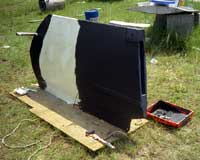 |
(My initial impression was it was about a 5 degree angle, but
I was so rushed I didn’t take time to measure. When I did
measure the next time the boat was out, it came out at closer
to 10 degrees.)
The second glitch became evident soon after leaving the boat
yard. With the fixed keel, Bolger has specified fairing blocking
inside the case and even with the boat bottom. They helped brace
the fixed keel at the keel along the bottom and also streamlined
the water flow — instead of a 5.5-inch gap, it was only
½ inch. The blocking was also a handy place to mount a
depth finder transducer forward of the keel and a mechanical knot-log
propeller behind the keel, without putting any holes in the hull
(the necessary wiring ran through the top of the keel case, well
above the waterline). Obviously with a keel that retracts like
a centerboard, such solid fairing was not possible, and the keel
case was entirely open on the bottom. The first thing I noticed
after relaunching was a ruckus of water inside the aft end of
the case. Not anticipating this problem, the caulking of the top
of the keel case had been haphazard, and water spurted through
the cracks at the aft end whenever the speed got over three knots.
Better caulking fixed the seepage, but it was also obvious the
extra drag was slowing the boat, anywhere from ½ to 1 knot
was my best guess. Think about sailing at, say, five or six knots
and then putting a 2 by 6 timber over the side, the flat face
perpendicular to your course and about a foot deep (don’t
try this, you could get hurt!). That’s the extra drag that
had been added.
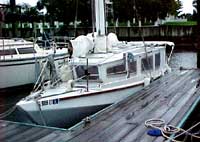 |
Le DulciMer at the dock on a recent rainy
evening.
(click to enlarge) |
If those were the immediate problems, there were also some benefits.
In the initial sails, the boat maintained her momentum much better
through tacks. Leeway seemed reduced, although I never made any
precise measurements. What wasn’t closely checked right
away were my tacking angles.
That was rectified in the course of an embarrassing race, albeit
against fairly practiced racers. Previous casual contests with
the original fin keel against the typical racer-cruisers at most
marinas had established the boat was usually just a bit slower
and not quite as close winded as those craft, but usually faster
running and reaching. That day, in a two lap race, we got lapped.
Before the boat had with attention, would do 100 degree tacks,
and 110 degree tacks would be done with little attention. Ths
time, the first real dedicated windward work with the new keel,
it was difficult to make good 120 degree tacks, and the speed
was obviously off.
| top view of the keel (in our van), showing again the mounting
bar and the bottom opening of the keel, through which the
ballast control bat will pass. |
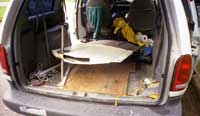 |
Before the race began, I had heard a small bang on the boat,
and had assumed it was some piece of rigging shifting or straightening
a kink. Nothing seems to change about the boat. But after the
race, I found a small leak had started around the front of the
keel case. The miracle of underwater epoxy got the leaks stopped
from inside, but I was surprised to find one of the leaks was
around the lower of the two half-inch stainless bolts holding
the headboard to the keel headblock.
It was a few weeks later before I thought to shine a flashlight
down the opening at the top of the keel case cover where the lifting
pendant exits. To my horror, the top of the ballast control bar
headboard (which is above the waterline) had pulled almost 1/4-inch
away from the keel case headblock. No wonder the bottom bolt,
which is below the waterline, had leaked. It didn’t appear
to be an immediate danger of catastrophic failure, because I had
been out sailing several times since, including partially raising
and lowering the keel. But it was obvious repairs were needed.
Scheduling problems (and the fact the nearest boatyard is 38
miles away) gave me plenty of time to think about potential fixes.
I also decided to make the cockpit and footwell changes that had
been bypassed in the earlier renovations, and do something about
the drag of the keel case slot.
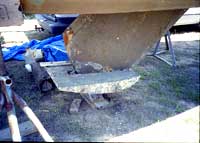 |
the wing keel operating as originally designed.
Here the keel is retracted about halfway, the wings are remaining
parallel (more of less, there was actually an uptilt to the
trailing edge that doesn't show in this pic) to the bottom
of the boat. |
The time finally came, and the boat was hauled and the work
begun. After a couple days of hard work, the headboard was heavily
caulked with 3M 5200 and the bolts refastened, and work on the
cockpit modifications had begun. Because of a shortage of blocking,
the boatyard had been unable to block the boat up high enough
to allow the keel to be fully lowered. I had raised and lowered
it as much as possible several times to test the fastenings with
no problems. Now the yard Travelift came and picked it up so the
keel could be lowered fully to allow some minor maintenance. I
climbed inside, lowered the keel, and climbed outside and had
one of my worst moments as a boat owner. The wings, which had
been cocked up almost 10 degrees at the aft end, were now hanging
down about 30 degrees. Something was obviously wrong. A check
of the headboard showed this time it had pulled about three inches
away from the keelcase headblock. It had failed catastrophically.
the wings hanging, somewhat
forlornly I think, after the headboard and ballast control
bar were removed after the headboard failure.
(click to enlarge) |
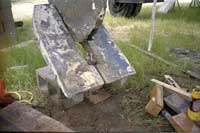 |
The triangular headboard was made of four layers of ½-plywood,
sandwiched around 1/4-inch thick fiberglass T-beams along the
edges of the two longest sides. Two D-shaped openings were cut
into the board a couple inches behind the forward edge to allow
the nuts to be applied to the thru-bolts. What had happened is
the top bolt, complete with washers and nut, had pulled through
the two-inch thick ply, which had more or less shattered. Apparently
the force, which was applied against the ply’s end grain,
was too great.
There were three choices: 1) get a new headboard made out of
heavy stainless steel (with at least eight bolts instead of two),
and disassemble the wings and keel, and then put everything back
together; 2) find a way to fix the wings in place so they no longer
cantilevered. The keel could be retracted, but the wings would
create more and more drag as the keel came up; or 3) remove the
keel and the keel case and replace them with a shallow fin to
enhance maneuvering, pull the mast and have a pleasant, if fairly
low-speed, power boat.
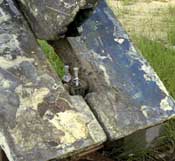 a
close-up of the remaining stub of the ballast control bar
with two 3/8-inch bolts, set in epoxy. When the wings are
in the proper position, the bolts will be in the keel cavity,
which was filled with epoxy. There is also a failed plywood
plate on the bottom of the wings with three half-inch bolts
running into the cavity and embedded in the epoxy, which is
8-10 inches deep. (click to enlarge) a
close-up of the remaining stub of the ballast control bar
with two 3/8-inch bolts, set in epoxy. When the wings are
in the proper position, the bolts will be in the keel cavity,
which was filled with epoxy. There is also a failed plywood
plate on the bottom of the wings with three half-inch bolts
running into the cavity and embedded in the epoxy, which is
8-10 inches deep. (click to enlarge) |
I picked the second option. Partly it was because that would
be the easiest, but also it would allow better fairing where the
wings meet the keel. Because the wings had to pivot, there was
a gap between their inside edge and the keel, indeed it was nearly
an inch wide at the forward end. I suspected turbulence there
had at least some minor detrimental effect on boat speed. It would
also allow me to get the wings as precisely as possible parallel
to the waterline — goodbye out of kilter wings, which I
also suspected had also contributed to drag.
Option 2 was the choice. Bolts were mounted in a faired plywood
plate along the bottom of the wings, with the bolts extending
into the keel cavity. The ballast control bar — which was
still attached to the rear pivoting bar in the wings — was
cut off. A couple bolts were mounted into the stub, which still
reached into the keel cavity. The openings around the keel cavity
were carefully sealed (using duct tape and expanding foam) and
the bottom 8 to 10 inches of the cavity were filled with epoxy,
locking the bolts into place. (Since the keel is no longer free
flooding, the top also had to be covered.) It shows no weaknesses.
Of course, the wings were carefully leveled to match the waterline
before this was done. The last step was filling and fairing the
gaps between the inboard edges of the wings and the keel. The
minimum draft is now about 3 feet, with all kinds of turbulence
as the wings are at a 45 degree or more angle to the water. I
joke that it is the only sailboat with built-in brakes. In reality,
the keel is only raised under power and at low tide (and then
to about the four foot level) so I can get in and out of the channel
that leads to the dock.
| the keel in its final form, no longer pivoting.
Note the fairing along the inside edge of the wings. You can
make out two "spots" on the side of the wing. Those
are the half-inch bolts (with big custom washers) that hold
the wings on to the two bars. (click
to enlarge) |
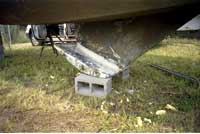 |
Interestingly, immobilizing the wings does give a bit of control
over the angle of the wings. They were installed to be level with
the waterline when the keel is fully extended. If a degree of
two of wing trim is desired to improve windward performance, the
keel just has to be raised an inch or two. I look forward to experimenting
with this.
As for the keel slot turbulence, strips of 1/8 by 4-inch rubber
were screwed to each side of the bottom. The strips are cut out
to match the profile of the keel in its full down position, but
otherwise leave about a 1/4-inch gap in the middle aft of the
keel. As the keel is raised, the rubber bends to allow it to retract,
and then returns to cover the slot when the keel is lowered.
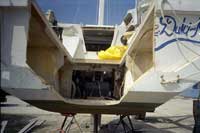 |
the cutout in the transom, hull bottom and the flush cockpit
necessary to install the footwell and new motor mount. Yes,
it is traumatic cutting up your boat like this.... (click
to enlarge) |
The new footwell and motor mount modifications were accomplished
in a straightforward manner.
So how did it work out?
Well, the first thing noticed as the boat accelerated away from
the boatyard was a lack of fuss in the keel case. The rubber strips
(and probably fairing around the wings and the correcting of the
canted wings) were doing their duty. And the boat felt much more
alive. Before at half throttle, the speed had been 3 mph. Now
it was 4 and even a little bit better. Top speed was a bit over
6 (this with a 30-year old Evinrude 6 hp outboard) — as
good or maybe a bit better than with the old fin keel.
As for sailing, she feels much more lively, especially to windward.
It’s only been out twice, once on a light air day and once
on a light to moderate breeze. Perhaps the most surprising trait
is by the compass, she consistently did 90 degree tacks on both
days. In fact, she could be pinched up, at a loss of speed, to
do 80-degree tacks — something almost unheard of with four-sided
sails. It’s not clear that all to the good; the GPS indicated
leeway on both tacks, but then we were sailing into a flood tide.
I did see on one tack when we passed a racing buoy that the boat’s
wake drifted considerably to leeward, but I’m not sure if
that was tide or surface drift. What’s really needed is
a day when the wind is blowing 90 degrees to the tidal current,
or getting further out from shore where the current is less. Reaching
and running speeds are good. We did 4 mph downwind with the remaining
tail wind so light I could barely feel it.
| the finished transom,
although the details don't stand out in the white paint. (click
to enlarge) |
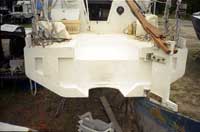 |
The new footwell takes some getting used to but makes sitting
easier. The new motor arrangement is an unmitigated success. The
motor is much easier to get at, start, control, and generally
use. It's easy to throw both the motor and tiller hard over and
turn the boat around in only a little more than its length —
handy if tight maneuvers are needed in the 100-foot wide canal
where the boat is docked.
What’s been learned? It’s still too early to reach
any final conclusions about this wing keel. It does seem to help
maneuverability, has apparently improved pointing ability and
has given me a bit of a shoaler draft craft. The wing controlling
mechanism had some teething problems, but I’m satisfied
it can work. The next generation of this concept needs to address
the stronger headboard for the ballast control bar, and a way
to adjust the angle of the wings without disassembling everything;
neither is an insurmountable problem. (Bolger in one drawing of
the keel arrangement seemed to show an opening in the keel side
by where the ballast control bar meets the headboard, but there
were no written instruction on it. That would be one way to address
the adjustment issue. There are, by the way, inspection ports
above the water line in the keel case to allow access to various
parts of the keel. I’ve already given my solution above
for the headboard.)
 |
the footwell and motor mount right after
relaunch, while we're motoring home. The cockpit is still
untidy from all of the boatyard work.
(click to enlarge) |
After many years of tinkering, both after the initial launch
and after the recent revamping, the boat is nearly in its final
form. I’m certain it will be more useable for its home waters,
and hope to learn over the next few months how to get the best
out of its sailing abilities. Perhaps there will a further report
on that.
In the meantime, my interest in pivoting wingkeels has been
stimulated. But if I do any more experimenting, it will be on
a smaller boat where disassembly and maintenance can be done on
a trailer at home, instead of a boatyard. Maybe a daggerboard
with fixed wings. Or a small centerboarder. Or how about a leeboard
with pivoting wings????? |

